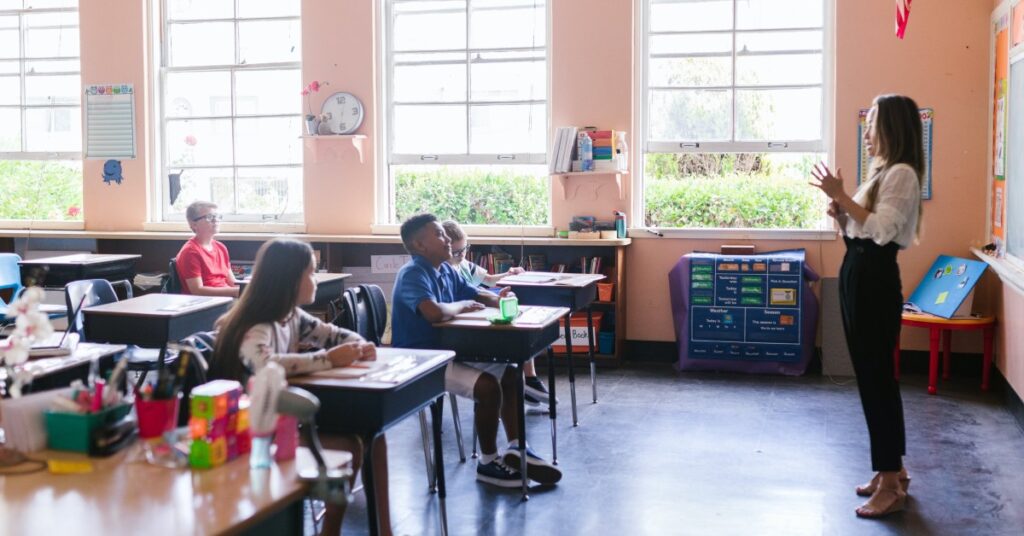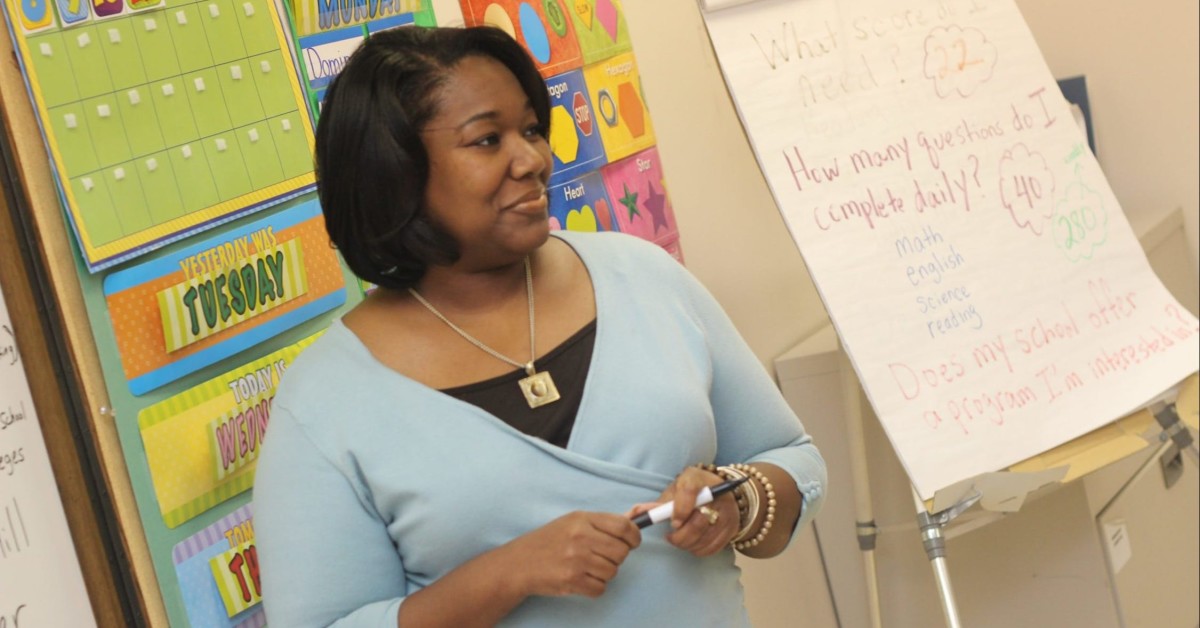
What Do Math Teachers Earn in 2020?
As a math teacher, you may qualify for higher pay [...]

Anyone who’s ever considered becoming a teacher knows that it’s typically a multi-year process in which you earn your undergrad and graduate education degrees. These traditional teacher training programs also require that student teachers log only about 100 hours of in-person instruction where they develop lesson plans, learn classroom management, and test out their newly-acquired teaching skills in real life.
Fewer people are aware that there is a quicker way to become a teacher. Back in 2008, a lesser-known teacher preparation path emerged across the US—year-long student teacher residencies (where they typically log 1,000 hours of in-person classroom time) that often are undertaken while simultaneously earning an education master’s degree. With the support of government grants, these teacher residency programs sprang up across the country to pair educators-in-training with experienced mentor teachers in a high-need school districts, in an arrangement that not only produces cohorts of effective new teachers, but benefits all involved—the mentoring teachers and their students, and the host schools (more on that below).
Some of the best and longest-running teacher residency programs are operating in the heart of the Big Apple. So, how do you apply for one of these competitive education programs? And do you need an undergradate education degree or a master’s in teaching to qualify?
In this article, we’ll cover:
New York University—a major supporter of teaching residencies in New York—notes that these teacher training programs are modelled after medical residency programs. Instead of holding off teaching in-person toward the end of—or after—graduate school, teaching residents spend a whole school year in the classroom under the guidance of a mentor teacher.
Residencies consist of either a full or half-day teaching in the classroom—with coursework done at night and on weekends. Student teachers apply the lessons learned through their master’s degree coursework on a daily basis, while receiving feedback from their mentor teachers throughout the academic year. When linked to a university, students earn a Master of Arts in Teaching (MAT) or a similar graduate education degree.
You’ll find teacher residency programs across New York at traditional institutions and through both nonprofit and private teacher-training programs. For example, government-funded programs, such as NYC Teaching Fellows, are operated directly by the New York City Department of Education (NYC BOE).
In many cases—particularly in cities like NYC—students work in high-need public or charter schools, and commit to working for a set period of time after their residency at the school is complete.
All New York teaching certification programs require applicants to have at least a bachelor’s degree in order to apply for a teaching residency program. Unlike many other traditional tracks, however, your undergrad degree does not have to be in education to qualify. In fact, the teacher residency route is particularly ideal for career changers who are eager to apply their newly-acquired knowledge in the classroom.
Teacher shortages across the country—particularly in NYC—have led residency programs to open their eligibility requirements to professionals from a range of experiences. Residency programs, as a whole, welcome students with new perspectives from a variety of educational and professional backgrounds to the field.
On a practical level, teacher residency programs significantly cut down the time it takes to obtain your teacher certification. Previously, a five-to-seven-year combination of undergrad and graduate programs was your primary option. However, many teacher residency programs take only one or two years to complete, incorporating both your first year of teaching and your master’s education program at one go.
Early research suggests that teacher residencies help support underserved school districts, provide the student teachers with more in-depth cultural awareness, and produce effective teachers. At the end of the day, properly preparing teachers is all about serving every individual student and their unique learning needs. Not only are teacher residencies a successful means of producing qualified teachers, but they are having a direct impact on learning as well.
A 2020 annual report by the National Center for Teacher Residencies (NCTR) found that over 60% of teaching residents identify as people of color, which is 40% higher than the number of new teachers of color entering the field from traditional education degree programs. The organization also notes that more than 20% of residents are specializing in STEM subjects, which is helping to address the dearth of STEM teachers at schools across the country.
Perhaps unsurprisingly, It turns out that pairing a student teacher with a veteran educator is a recipe for classroom success. Researchers at Glass Frog Solutions found that having a teaching resident in the room increased a host teacher’s effectiveness score (TES). So, not only do student teachers learn the skills they need to go on to become great teachers, but their very presence as a mentee positively impacts everyone else in the classroom during the residency as well.
Also of note, the NYC DOE also has found that their NYC Teaching Fellows program has raised the overall NYC public school student graduation rate by an impressive 20% (and decreased the dropout rate by 10%).
It’s one thing to work in a high-need school for a year, it’s another to stick around to help address a community’s educational needs over the course of your career. The NCTR found that 86% of student teachers in residency programs stayed with their host schools in the three years following graduation.
| University and Program Name | Learn More |
|
New York University:
Master of Arts in Teaching
|
|
|
Merrimack College:
Master of Education in Teacher Education
|
Every state and jurisdiction has its own teacher certification program, and NYC is no different. It’s best to start with the NYC DOE website to learn about the process for finding a residency program. Universities like NYU, Columbia, CUNY’s Brooklyn College, and Pace University—among other major players—all provide top-notch alternate residency programs.
The NYC DOE also supports several many nonprofit and state-funded programs such as NYC Teaching Fellows, the NYC Teaching Collaborative, and the NYC DOE Urban Teacher Residency.
Each resident program in NYC has a highly structured eligibility, schedule, and application process, typically for the following school year. For traditional graduate programs with residency options, students should apply through the regular school admissions process. However, each government-run, nonprofit, and private school accepting applications has a unique online process based on its needs at that given time.
NYU specifically breaks down the number of credit hours in subjects like English, math, and science to determine eligibility. Individual universities often will set their own track for residency approval within their one or two-year programs.
The NYC Teaching Fellow program, on the other hand, requires a 3.0 GPA and a bachelor’s in any major, as well as fluency in English. Applicants cannot have been previously certified to teach anywhere else in the US or started any similar NYC training programs.
Coursework alongside the in-classroom residency varies depending on the partnering university. Classes themselves will hone in on both the fundamentals of teaching and the aspiring teacher’s chosen specialty.
Let’s take a look at Columbia’s Teachers College, for an example. Students explore the Teachers College Four Instructional Pillars of NYC schools, including STEM+C Literacy and Enrichment, Instructional Technologies and Assistive Technologies, Universal Design for Learning and Inclusive Curriculum, and Co-Teaching and Co-Planning Across Content Areas, Special Education, and TESOL.
Student teachers on the hunt for their ideal specialization can explore more options with hands-on experience. In most cases, a program will ask both career changers and recent college graduates to identify their intended pathway when applying.
Most programs are split between early childhood education and secondary school. Others provide the option of further specialization in areas like science, math, English, and special education.
Teacher residencies typically range between one and two years and can be earned simultaneously with an MAT.
You’ll find a range of creative program structures throughout the city. The New Visions Hunter College Charter Residency takes 24 months. Student teachers slowly increase their responsibilities over three trimesters, eventually taking on a full course load as a lead teacher, in preparation to transition to their career after graduation.
Many teacher residencies receive federal grants to either subsidize or fully fund their programs, in an effort to recruit as many students to this field as possible. Teachers College breaks down its $70,000 stipend between tuition and living expenses. The school estimates that its students will pay between around $6,400 and $15,600 out of pocket as of 2021.
The NYC Fellow program works a bit differently. Fellows receive a small stipend during the pre-training period, but are responsible for books, materials, and administrative costs like fingerprinting and background checks. The fellowship does not cover the cost of living in NYC and tuition costs come out of the teacher’s salaries once they are hired full-time after graduation.
Sticking with your residency school is a popular choice for many teaching residency graduates and for good reason. You’ve built a rapport with faculty and students, learned the lay of the land, and aligned yourself with the mission of the school.
Some programs, such as NYC Teaching Fellows, require graduates to accept positions from schools that receive federal Title I funding (supplemental support for schools that serve a high number of low-income children).
As a teaching resident, you’ll have the opportunity to develop your skills alongside the same community that welcomed you to the classroom on day one. By developing trust, enthusiasm, and true awareness of the challenges of teaching, you can look ahead to a highly rewarding career after an immersive education.
Questions or feedback? Email editor@noodle.com

As a math teacher, you may qualify for higher pay [...]

If you're looking to quickly (and inexpensively) earn your MAT [...]

The beauty of online teacher residency programs is that after [...]

Pharmacists may be the unsung heroes of patient healthcare, providing [...]

San Francisco teacher residency programs offer the opportunity to earn [...]
Categorized as: Elementary Education, Secondary Education, Education & Teaching